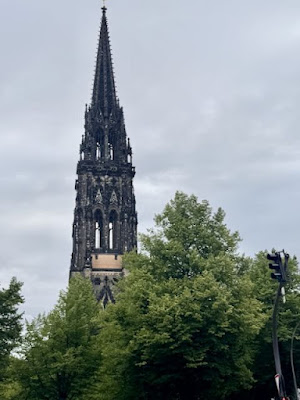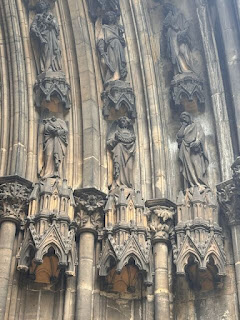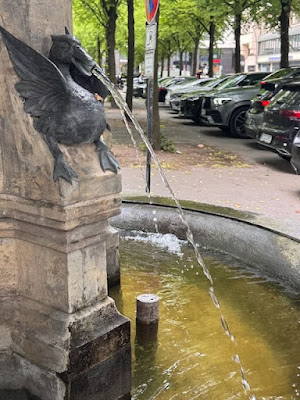St. Nikolai was the second historic place OFD and I visited in Hamburg while exploring on our own.
The origins of St. Nickolai Church go back to the 12th century when a chapel was built in honor of St. Nikolai, the patron saint of sailors and travelers. In the course of the centuries, the church was rebuilt and extended several times.*
The church burned down completely during the Great Fire of 1842. From 1846-1882 the new St. Nikolai Church was built in the new-Gothic style according to the plans of the English architect George Gilbert Scott. The 147.3-meter-high steeple was the tallest in the world at the time. During the Second World War, the steeple's height served as an orientation point for Allied bomber pilots approaching Hamburg.*
The Church of St. Nicholas was formerly one of the five Lutheran Hauptkirchen in the city of Hamburg. ~ Wikipedia
The original chapel, a wooden building, was completed in 1195. ~ Wikipedia
As we walked through the nave and up the steps, threading our way among other tourists, I did not realize what had become of St. Nikolai. I just thought, seeing the headless statues, it was a church in need of some serious TLC.
Heavily destroyed in the summer of 1943, the church was not rebuilt after the war, but declared a memorial.*
Angel on Earth, bronze sculpture by Edith Breckwoldt
Seeing the open sky above what would have been the main body of the church, I had feelings similar to those I experienced in Dachau, the Concentration Camp Memorial near Munich.
In July 1943 Allied airplanes attacked the city of Hamburg. During the air raids more than 35,000 people died and 900,000 became homeless. 250,000 houses were destroyed, so was the church of St. Nicholas. (signage at the church)
The St. Nikolai Memorial commemorates the victims of the bombings in the context of the National Socialist war of extermination. It connects the present with the past and the future.*
Panels in German and English speak unblinkingly of the war:“The original catastrophe occurred … in 1933, when the National Socialists, with the support of large parts of the elite and the population abolished democracy and the rule of law in a matter of weeks. This catastrophe was to bring on all the tragedies that followed.”There are no excuses at St. Nikolai, and no glorification of the conflict that left it a hulk. There are only admonitions and challenges to be carried away into the hiss of traffic outside." ~ Waymarking Angels on Earth
In 1993, the carillon was installed in the steeple, where the organ was located before the Second World War. It comprises 51 bells which can be seen and heard from the open space of the former nave. With a range of more than four octaves, the carillon is one of the largest in Germany.*
The museum in the historic vaulted cellar offers visitors the opportunity to learn about the causes and consequences of the war.*
*Information taken from the pamphlet Mahnmal St. Nikolai
The ruined church was dedicated as a memorial site in 1977, and a plaque was installed in memory of the victims of the bombing in Hamburg.
Across from the front of the church, a small park with flowers and benches. A place to reflect.
Vierländerin Fountain
built in 1878, heavily damaged in WWII, moved to this location 1975,
renovations completed in June 2019
on the fountain, one of four ducks spouting water
In the fountain basin stands the statue of a young woman from the Vierländer region in traditional regional costume. She is leaning on a yoke, and behind her is a basket of vegetables at her feet. The stone statue base bears the inscription “At the market you get to know people” distributed around its four sides. ~ Wikipedia
Saint Ansgar Statue on Trostbrücke bridge, Hamburg
Hamburg, Germany, is known as the "Venice of the North" due to its extensive network of over 2,500 bridges, more than any other city in Europe. These bridges span rivers, canals, and the port area, connecting various districts and offering unique views of the city. ~ AI


















No comments:
Post a Comment
Thanks for your comments!